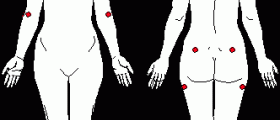
Piriformis syndrome is a medical condition that develops due to irritation of the sciatic nerve. Such irritation is associated with compression of the nerve within the buttocks by the piriformis muscle. The pain, which is a typical characteristic of piriformis syndrome, intensifies with contraction of the piriformis muscle and is more severe during prolonged sitting or direct pressure applied to the muscle.
Injuries and the Syndrome
The piriformis muscle is a main candidate for repetitive motion injury. This type of injury occurs when a muscle is forced to perform certain exercises beyond it's level of capability. Furthermore, if the muscle is not allowed to rest properly and then forced to perform the same level of exercise once again, the damage is inevitable.
Piroformis Syndrome Clinical Characteristics
The initial symptoms that may point to the onset of piriformis syndrome is pain in and around the outer hip bone. Muscle tightness is responsible for tension increase between the tendon and the bone. This may cause further inflammation in a form of bursitis.
The second symptom that drive doctors to diagnose piriformis syndrome is pain located directly in the center of the buttocks. Such pain is easily elicited by compression.
And finally, one more characteristic of the syndrome is a sciatic neuralgia i.e. pain that radiates from the buttocks down the back of the leg, reaching different portions of the affected leg. Such pain is easily explained. Namely, the sciatic nerve runs through the belly of the piriformis muscle and in case the muscle is overused, the nerve gets easily strangled which results in pain and additional symptoms and signs of the nerve irritation.
Diagnosing Piriformis Syndrome
The doctor sets the diagnosis by excluding other causes and conditions. During physical examination, the most important thing is to differentiate sciatic pain associated with actual damage to the nerve from piriformis syndrome. If there are no neurological deficits, the person is diagnosed with piriformis syndrome. There is no disc herniation. The only positive sign is tenderness of the gluteal region.
Piroformis Syndrome Treatment
Resting and timely onset of physical therapy are efficient treatments for piriformis syndrome. Moist heat and ultrasound can be of additional help in recovery and are generally applied prior stretching the affected muscle. Tightness of the affected muscle is decreased with soft-tissue massage. And finally, cold packs and sometimes electrical stimulation may be applied as additional treatments.
Occupational treatment is recommended in patients whose symptoms tend to worsen. Similarly, patients with intensive and uncontrollable symptoms require surgical approach (release of the piriformis tendon and sciatic neurolysis).













-vs-Trigger-Points-(Myofascial-Pain-Syndrome)_f_280x120.jpg)



Your thoughts on this
Loading...